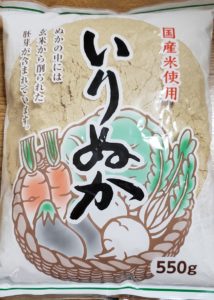How to Make Nukazuke
投稿日:2019年6月6日 更新日:
Day 1 (5/31)
I wanted to make nukazuke (rice bran pickles) and bought rice bran at the supermarket. I also wanted to make nuka pack (rice bran face pack) to make my face skin more beautiful; so I chose rice bran without salt. The 550 gram pack of rice bran cost 128 yen. Cheap!
<Rice bran>I used half of the rice bran for pickles.
-Rice bran: 280 g
-Natural salt: 50 g
-Mineral water: 350 cc
According to the instruction of the package, I mixed natural salt and mineral water and put the salt water in the refrigerator for cooling in a short time.
The instruction said, “Mix rice bran and saltwater until nukadoko (rice bran bed) gets miso-like hardness.” I wondered how hard it would be …, but my nukadoko naturally became exactly like miso soon. The mixture was about 700 gram in total (rather small amount as nukadoko).
The above was the first process to make nukazuke. I should have let it rest for 4 days to make it better flavor and condition.
Day 5 (6/4)
After letting the nukadoko rest, the test pickling should be done.
The reason and how to do the test pickling: (According the instruction)
Just mixed nukadoko is too hard and does not have a good taste because rice bran and salt have not been mixed rightly and fermentation has not been proceeded yet.
Firstly, pickle the root or stem of cabbage to give adequate water and sweetness from vegetable to the nukadoko.
So, I prepared 250 g of so-called vegetable scraps. I put some cabbage core, the end part of cucumber and peels of carrot and daikon (Japanese radish) into the nukadoko after taking extra water from the vegetables with paper towels.
The instruction also said …
※*Some dried kelp, dried siitake mushroom and red pepper would make the nukadoko tastier.
I added some dried kelp and red pepper.
The instruction didn’t show how many days the test pickling should be continued. I decided to let the vegetables rest as same time as usual pickling. From this time, I kept the nukadoko in the refrigerator because fresh vegetables were included and it has already been hot in June (over 30 degrees Celsius; daytime).
Pickling time
-Spring/autumn: 8-9 hours
-Summer: 5-6 hours
-Winter: 20-24 hours
*When the nukadoko is kept in the refrigerator, the pickling time should be same as the wintertime.
<In the refrigerator>
Day 6 (6/5)
I pickled cucumber, carrot and daikon.
As the instruction said, “pickling time will be shorter after salting the vegetables,” I salted and let them rest for 30 minutes, and then washed the salt, took extra water from the vegetables with paper towels and pickled them finally (rubbed salted rice bran hard to vegetables).
I tried some test pickled cabbage scraps, they tasted better than I expected. I left the test pickles as they were.
Day 8 (6/7)
The vegetables had been pickled. It was time to taste them.
They tasted not only vegetables themselves, nor simply salty, but sweet grain of the earth; tasted exactly like nuka (rice bran). The nukazuke would taste differently when fermentation would be naturally processed; it would taste a little bit sour in a good way, far deeper …
Related article: How to Make Rice Bran Face Pack
執筆者:椎名のらねこ
関連記事
-

-
Flavored cream cheese I am a salesperson at a supermarket. I cook and serve food product to customers. One day, I sold cream cheese at a supermarket. A couple in their 60s were talking about cream cheese that I was selling. The husband asked to his wife, “Can I cut this cream cheese for use? (Wasn’t it too soft to cut?)” At first, I did not understand what they were arguing about, but in the meantime I cut the cream cheese into a mouthful size with my hands, stabbed it with a toothpick and handed it to the husband. He …





